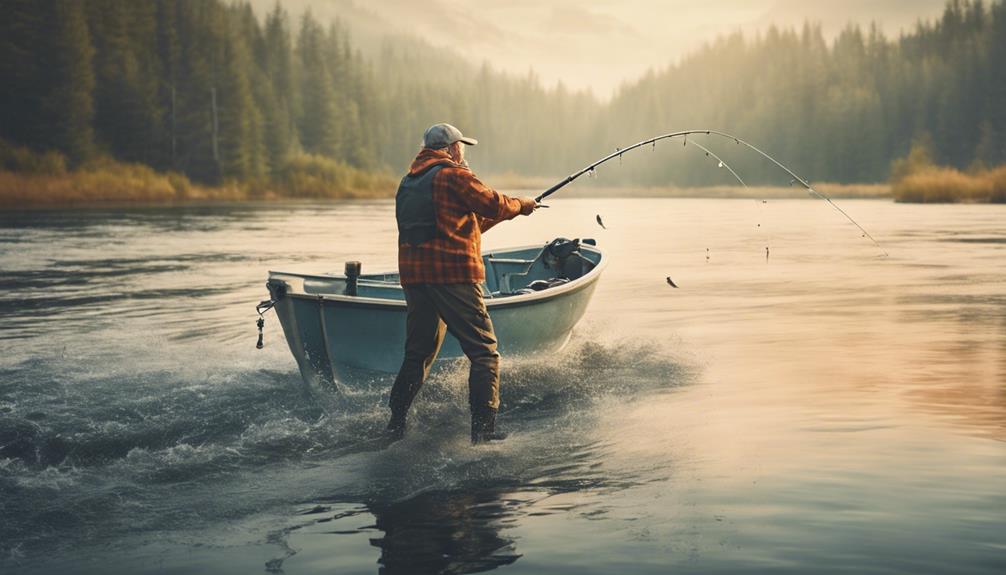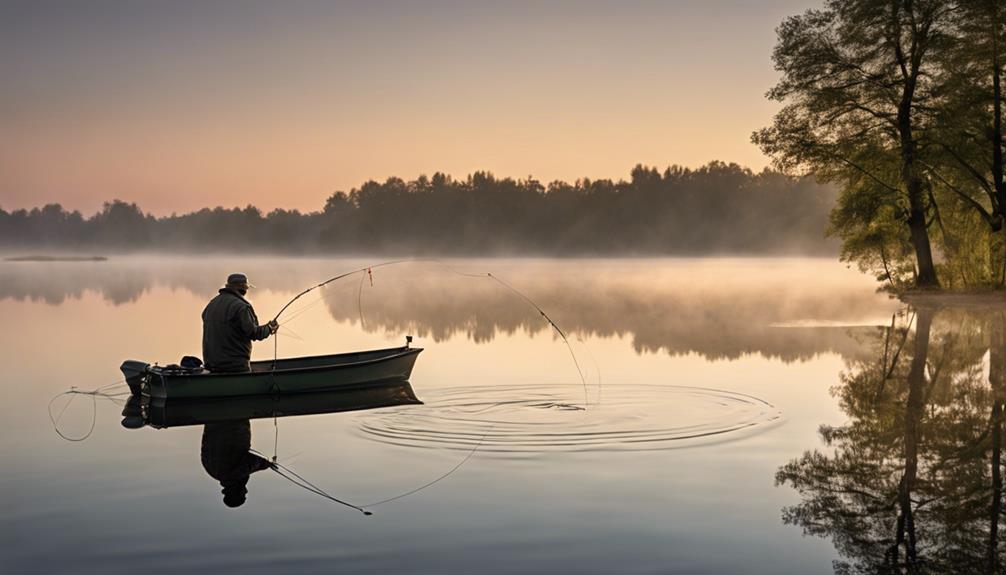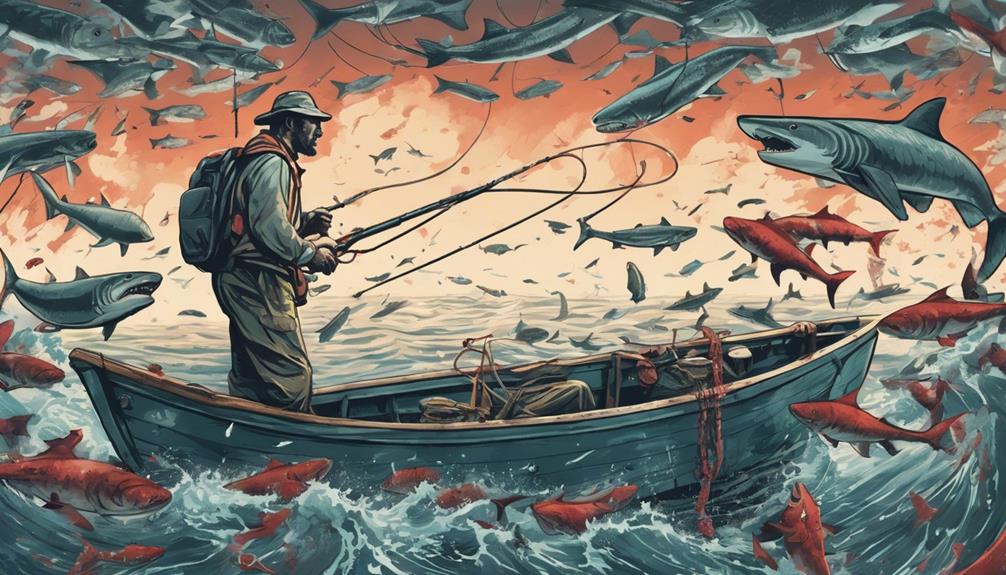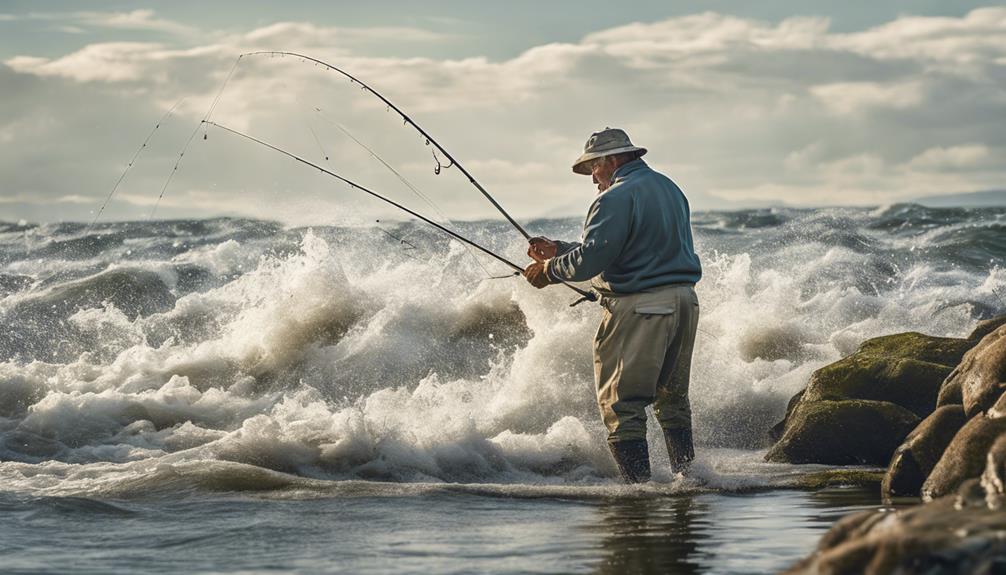When it comes to salmon fishing, did you know that the average weight of a Chinook salmon can reach up to 30 pounds? Imagine the thrill of reeling in such a magnificent catch.
But to achieve success in salmon fishing, you need more than just luck. By mastering the six best techniques that seasoned anglers swear by, you can significantly increase your chances of landing that prized salmon.
So, let's explore these tried-and-tested strategies that will elevate your salmon fishing game to the next level.
Choosing the Right Gear
To ensure a successful salmon fishing experience, start by selecting the appropriate gear for the job. Gear maintenance is crucial to ensure your equipment functions properly when you need it. Before heading out, check your rods, reels, and lines for any signs of wear and tear. Replace any damaged components to avoid disappointment on the water.
Equipment selection plays a vital role in your fishing success. Make sure to research the specific regulations in the area where you plan to fish. Different locations may have different rules regarding gear restrictions, so it's essential to be informed to avoid any legal issues. Once you're aware of the regulations, choose the right tackle for the type of salmon you're targeting. Customizing your tackle to match the size and behavior of the salmon in that particular area can significantly increase your chances of a successful catch.
Take the time to customize your tackle for the best results. Adjusting the weight of your lures, the strength of your lines, and the type of bait you use can make a significant difference in attracting salmon. By tailoring your gear to the specific conditions of your fishing spot, you increase your chances of a fruitful fishing excursion. Remember, preparation is key when it comes to selecting the right gear for salmon fishing.
Understanding Salmon Behavior
Understanding salmon behavior is essential for maximizing your fishing success and increasing your chances of a rewarding catch. To improve your fishing game, it's crucial to grasp how these magnificent fish behave in their natural habitats. Here are some key insights into salmon behavior that can help you become a more successful angler:
- Spawning Habits: Salmon are known for their remarkable spawning habits, where they travel from the ocean back to freshwater streams and rivers to reproduce. Understanding the timing and location of salmon spawning grounds can greatly enhance your chances of encountering them during this critical phase.
- Feeding Patterns: Salmon exhibit specific feeding patterns influenced by factors like water temperature, time of day, and available prey. By learning about what salmon feed on and where they're likely to find food, you can strategically position yourself for a successful fishing expedition.
- Migration Routes and Predator Evasion: Salmon undertake incredible journeys during their migrations, navigating vast distances through various water bodies. Knowing the typical migration routes of salmon can help you intercept them along their journey. Additionally, understanding how salmon evade predators in the wild can guide your fishing strategies, allowing you to anticipate their movements and behaviors more effectively.
Perfecting Your Casting Technique
Improving your casting technique is crucial for effectively targeting and landing salmon during your fishing expeditions. When it comes to perfecting your casting technique, two key elements to focus on are timing accuracy and line control. Timing accuracy is essential for ensuring that your lure or bait lands in the perfect spot where salmon are likely to be present. By mastering your timing, you increase the chances of enticing a salmon to bite.
Line control is another vital aspect to consider. Maintaining control of your line throughout the casting process allows for smoother and more accurate casts. This control enables you to place your lure precisely where you want it, increasing the likelihood of attracting salmon to your bait.
In addition to timing accuracy and line control, precision casting and distance control are crucial for successful salmon fishing. Precision casting involves the ability to place your lure with accuracy, especially when targeting specific areas where salmon are known to gather. Distance control is equally important, as it allows you to reach distant spots where salmon may be present, giving you a broader range to explore and fish effectively.
Mastering Different Fishing Methods
Master different fishing methods to expand your skills and increase your chances of a successful salmon fishing experience. By mastering a variety of techniques, you can adapt to different conditions and maximize your catch. Here are some key methods to consider:
- Trolling techniques: Trolling involves trailing bait or lures behind a moving boat. To excel in trolling, vary your trolling speed to find the optimal pace that entices salmon to strike. Experiment with different lure colors and sizes to determine what the fish are actively feeding on. Additionally, consider using downriggers to control the depth at which your bait or lure is presented.
- Fly fishing strategies: Fly fishing is a classic method that requires precision and finesse. Invest time in learning how to cast accurately and practice different fly patterns. Understanding the insect hatches in the area can help you select the right flies to mimic natural prey. Be mindful of your presentation and try to match the hatch to increase your chances of success.
- Drift fishing tips: Drift fishing involves allowing your bait to drift naturally with the current. Use sensitive gear to detect subtle bites, and adjust your weight to maintain contact with the riverbed without getting snagged. Experiment with different baits such as roe or shrimp to see what the salmon are actively feeding on.
Reading Water Conditions Effectively
To enhance your salmon fishing success, it's crucial to develop a keen eye for reading water conditions effectively. Proper positioning is key when it comes to maximizing your chances of catching salmon. Observing the water flow is essential in determining where the salmon are likely to be present. Look for areas where the water current changes speed or direction, as these can create ideal spots for salmon to hold and feed.
Identifying hotspots is another critical aspect of reading water conditions. Keep an eye out for structures such as rocks, logs, or underwater ledges where salmon may seek shelter or where baitfish gather. These areas can attract salmon looking for food or protection, presenting you with prime fishing opportunities.
Depth plays a significant role in salmon fishing success. Depth can vary greatly within a body of water, so it's essential to use tools like fish finders or depth maps to locate the optimal fishing spots. Salmon often prefer specific depths depending on factors like water temperature and available food sources. By understanding depth variations, you can target your fishing efforts more effectively.
Utilizing Proper Bait and Lures
When selecting bait and lures for salmon fishing, consider the specific preferences and behaviors of the salmon species you're targeting. To increase your chances of success, here are some key strategies to keep in mind:
- Bait selection: Choose bait that closely resembles the natural prey of the salmon in the area you're fishing. Common options include herring, anchovies, and squid. Fresh bait is usually more effective than frozen bait, so try to use freshly caught or store-bought fresh bait whenever possible.
- Lure presentation: Pay attention to how your lure moves through the water. Salmon are often attracted to lures that mimic the movements of injured baitfish. Consider using lures that have a realistic swimming action and color patterns that match the local baitfish.
- Depth adjustment, line control: Experiment with different depths to find where the salmon are actively feeding. Adjust your lure or bait accordingly to reach the desired depth. Additionally, maintain control over your line to feel for any subtle bites or changes in the underwater terrain that may indicate the presence of salmon.
Implementing Proper Hook Setting

Properly setting the hook when salmon fishing can significantly increase your chances of landing a catch. To ensure a successful catch, mastering the proper technique for setting the hook is crucial. When you feel a bite or a tug on your line, it's essential to resist the urge to immediately jerk the rod. Instead, reel in any slack quickly to ensure the fish has taken the bait properly. Once you feel the weight of the fish on the line, swiftly but smoothly, set the hook with a firm and decisive motion. This action drives the hook into the fish's mouth, securing your catch.
A common mistake anglers make is setting the hook too aggressively, which can result in the fish getting spooked and letting go of the bait. On the other hand, a weak hook set may not penetrate the fish's mouth effectively, leading to missed opportunities. Finding the right balance is key to a successful hook set.
Practicing Patience and Persistence
Developing patience and persistence is essential for mastering the art of salmon fishing successfully. When you're out on the water, waiting for that perfect catch, it can be easy to get frustrated or lose focus. Here are some key points to keep in mind to help you stay patient and persistent:
- Mental Preparation and Focus: Before you even cast your line, take a moment to mentally prepare yourself. Visualize a successful fishing trip, imagine the thrill of reeling in a big salmon, and focus on the task at hand. By getting in the right mindset, you'll be better equipped to handle any challenges that come your way.
- Handling Setbacks and Frustrations: Fishing doesn't always go as planned. You might lose a big catch, struggle with your equipment, or have a slow day on the water. It's important to remain calm and composed when faced with setbacks. Instead of getting frustrated, use these moments as learning experiences. Stay persistent and keep trying – the next catch could be just around the corner.
- Staying Committed: Remember, success in salmon fishing doesn't come overnight. It takes time, practice, and a lot of patience. Stay committed to honing your skills, learning from each fishing trip, and enjoying the process. With dedication and perseverance, you'll become a successful salmon angler in no time.
Frequently Asked Questions
How Can I Tell if the Salmon in the Area I Am Fishing Are Fresh or Have Been in the Water for a While?
To determine if the salmon in your fishing area are fresh or not, trust your senses. Fresh salmon will have a vibrant color, firm flesh, and a clean, oceanic smell.
When cooked, fresh salmon will have a rich taste and moist texture. This is crucial for successful fishing trips and ensures you enjoy the best possible catch.
Trust your instincts and always prioritize freshness for the best fishing experience.
Are There Any Specific Signs or Clues in the Environment That Can Help Me Determine the Best Time of Day to Fish for Salmon?
To determine the best time to fish for salmon, pay attention to water temperature and fish behavior. Additionally, keep an eye on moon phases and tides as they can affect salmon activity.
Look for signs like active feeding or jumping fish to indicate a good fishing time. Observing these environmental cues will help you pinpoint the optimal time of day to increase your chances of a successful catch.
What Are Some Common Mistakes That Beginner Salmon Fishers Make That Can Easily Be Avoided?
When you're just starting out with salmon fishing, it's important to avoid some common mistakes to increase your chances of success. Proper bait and tackle selection are key, as using the right gear can make a big difference in your catch.
Additionally, managing your line effectively and practicing patience are crucial. By avoiding these simple errors, you can set yourself up for a more successful salmon fishing experience.
How Important Is It to Be Aware of the Regulations and Limits for Salmon Fishing in the Area I Am Fishing?
It's crucial to be aware of the regulations and limits in your fishing area. Conservation awareness and ethical fishing practices are key to preserving salmon populations.
What Are Some Lesser-Known Tips or Tricks for Increasing My Chances of Catching a Larger or More Elusive Salmon?
When trying to catch a larger or more elusive salmon, consider experimenting with bait selection and trying different fishing techniques. Sometimes using unconventional bait can attract bigger fish, and varying your fishing methods can help you adapt to the behavior of elusive salmon.
Conclusion
So there you have it – with the right gear, knowledge of salmon behavior, and perfect casting technique, you can master the art of salmon fishing.
By utilizing different methods, reading water conditions, and using the proper bait and lures, you'll increase your chances of a successful catch.
Remember to always set your hook properly, practice patience, and never give up.
With these techniques in your arsenal, you'll be reeling in those salmon in no time!



